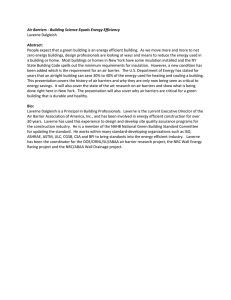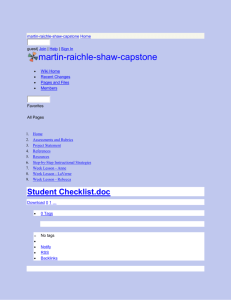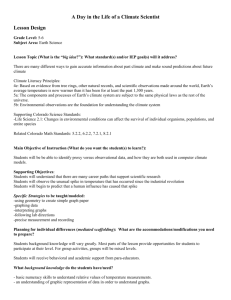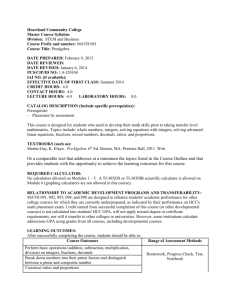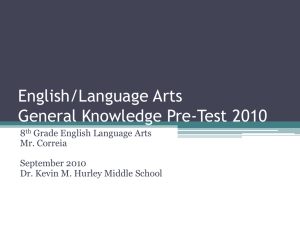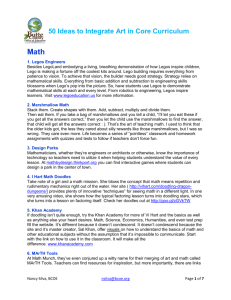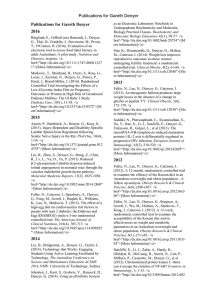Teaching Research, Paraphrasing and Presentation Skills With Civil
advertisement
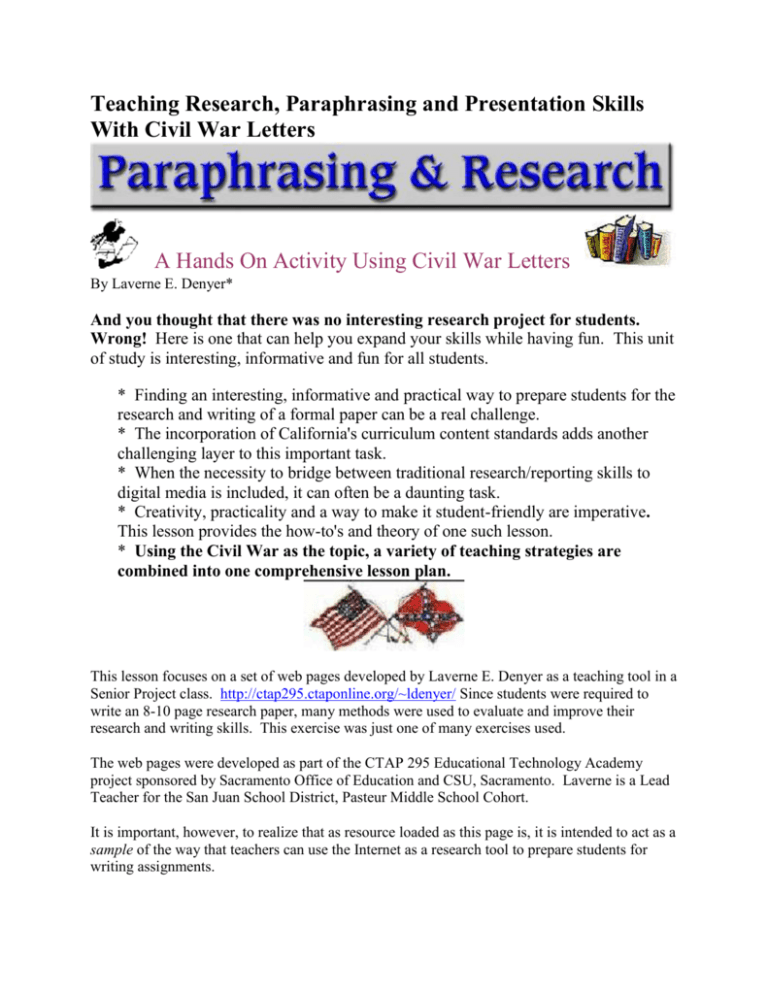
Teaching Research, Paraphrasing and Presentation Skills With Civil War Letters A Hands On Activity Using Civil War Letters By Laverne E. Denyer* And you thought that there was no interesting research project for students. Wrong! Here is one that can help you expand your skills while having fun. This unit of study is interesting, informative and fun for all students. * Finding an interesting, informative and practical way to prepare students for the research and writing of a formal paper can be a real challenge. * The incorporation of California's curriculum content standards adds another challenging layer to this important task. * When the necessity to bridge between traditional research/reporting skills to digital media is included, it can often be a daunting task. * Creativity, practicality and a way to make it student-friendly are imperative. This lesson provides the how-to's and theory of one such lesson. * Using the Civil War as the topic, a variety of teaching strategies are combined into one comprehensive lesson plan. This lesson focuses on a set of web pages developed by Laverne E. Denyer as a teaching tool in a Senior Project class. http://ctap295.ctaponline.org/~ldenyer/ Since students were required to write an 8-10 page research paper, many methods were used to evaluate and improve their research and writing skills. This exercise was just one of many exercises used. The web pages were developed as part of the CTAP 295 Educational Technology Academy project sponsored by Sacramento Office of Education and CSU, Sacramento. Laverne is a Lead Teacher for the San Juan School District, Pasteur Middle School Cohort. It is important, however, to realize that as resource loaded as this page is, it is intended to act as a sample of the way that teachers can use the Internet as a research tool to prepare students for writing assignments. CIVIL WAR LETTERS PARAPHRASING & RESEARCH PRACTICE LESSON PLAN LANGUAGE ARTS SKILLS By Laverne E. Denyer http://ctap295.ctaponline.org/~ldenyer/ I. Teacher Information: A. B. Standards Addressed 1. Grade Levels A. 11th & 12th Grades B. Adaptable for 6th through 10th Grades 2. Writing A. 1.6 Develop presentations by using clear research questions and creative and critical research strategies (e.g., field studies, oral histories, interviews, experiments, electronic sources). 3. Listening & Speaking A. 2.4 Deliver multimedia presentations: a. Combine text, images, and sound by incorporating information from a wide range of media, including films, newspapers, magazines, CD-ROMs, online information, television, videos, and electronic mediagenerated images. 4. Note: There is crossover into many other language arts standards besides the two listed. Instructional Objectives 1. Students will be expected to meet the following objectives 2. After reading one of the Civil War Letters, students will write a paragraph that paraphrases the entire letter and includes the name of the sender and recipient, the date written, and a minimum of three key points from the letter. 3. As part of a small work group after reading all five Civil War letters, students will compile a data list which itemizes at least four facts listed in the letters. 4. As part of a small group after reading all five Civil War letters, students will compile a list which of at least two conclusions inferred from the letters. 5. As part of a small work group after reading all five Civil War letters, students will formulate and write at least two follow-up questions related to the topic. 6. Using the small work group developed questions, individual students will create a word processed list, or data base, and description of at least two related web sites (including URLs) which address the formulated questions. 7. Using the materials developed in the previous steps, students will write a two page report, meeting MLA standards, which lists their findings, conclusions and questions. 8. As part of a small work group, students will combine their resources to develop a multimedia presentation that summarizes and presents each of the previous components, including graphics, sound, sound design components, and accurate language components. 9. As part of a small work group, students will give a presentation of their digital slide show to the large group employing acceptable informative speech skills. http://berners.bcoe.butte.k12. ca.us/~ldenyer/ Language Arts check sheet http://berners.bcoe.butt e.k12.ca.us/~ldenyer/st andards.htm 10. After all other activities are completed, students will complete a written evaluation of their performance as a group member and an individual. C. Student Activities 1. For this activity you will need A. Digital Slide Presentation (with Overhead transparency backup) B. Lesson Plan C. Computer with software D. Word Processing Software E. Digital Slide (PowerPoint, Publisher, Presentations, etc.) Software F. Graphical Organizer (Inspiration) Software G. Display Medium (overhead projector, computer with TV converter, LCD, etc.) H. Student Materials: a. Set of Five Civil War Letters b. Notepaper/pencils and/or computers c. Computer with software (same as above) – or overhead transparencies & pens d. Connection to the Internet for research e. Student Instructions in Document form 2. Introductory Activity A. Time: Approximately 1/2 hour B. Introduce the activity by using the slide presentation and holding a discussion about research materials: availability, how rich they are even when they seem skimpy, locating, etc. C. Pre-Test 3. Enabling Activities A. #1 Time: 1 hour (can go to 1 1/2 hours) a. Break students into small work groups (5 works the best). Have the group designate a facilitator, taskmaster and a recorder. b. Students: i. each read at least one of the five letters; ii. each student write a one paragraph summary/paraphrasing the letter; discuss all five letters; iii. take note of facts, suppositions and research questions; iv. create a list of facts, suppositions and research questions B. #2 Time: 1 hour a. Students individually research their questions using the Internet. Have them each create a webliography and a short catalog of illustrations to support their findings. C. #3 Time: 1 to 2 hours (depending upon resources, competency and available time) a. Students again work in their small groups to discuss their findings and create a digital display of their materials Digital Slides Lesson Plan 5 Letters Pre-Test (example -- will open new page). The display must be creative, include graphics, include all appropriate information (including the group members' names) and be user friendly. For schools with limited technology, a set of overhead transparencies could be substituted. D. Culminating Activity a. Time: 15 minutes per group b. Each small group gives an oral presentation, using their digital display project, of their work. 4. Assessment 5. Pre-Test 6. Group Evaluation A. Each student completes a written evaluation of their group work and their individual work. Remember, it is important that for the group evaluation, each student evaluates the group as a whole, minus themselves. For example, if there are five members in a group, the student would evaluate the other four members as a whole group with a potential of 25% of the work done by each. B. Rubric C. Teacher completes a rubric for each student's work. D. Post-Test D. Results 1. After implementing your lesson (sometime between January & March), insert a chart of your pre-test, post-test, and culminating assessment data. II. Web Resources & Supplementary Materials A. Introductory Activity 1. Introductory Digital Slide Show B. Enabling Activity 1. Internet sites: a. Index of Civil War Information Available on the Internet http://www.cwc.Isu.edu/cwc/civlink.htm An excellent resource with links to letters and journals — including a link to "Evaluating Internet Research Resources" b. Educational Technology Teacher Resource Links
